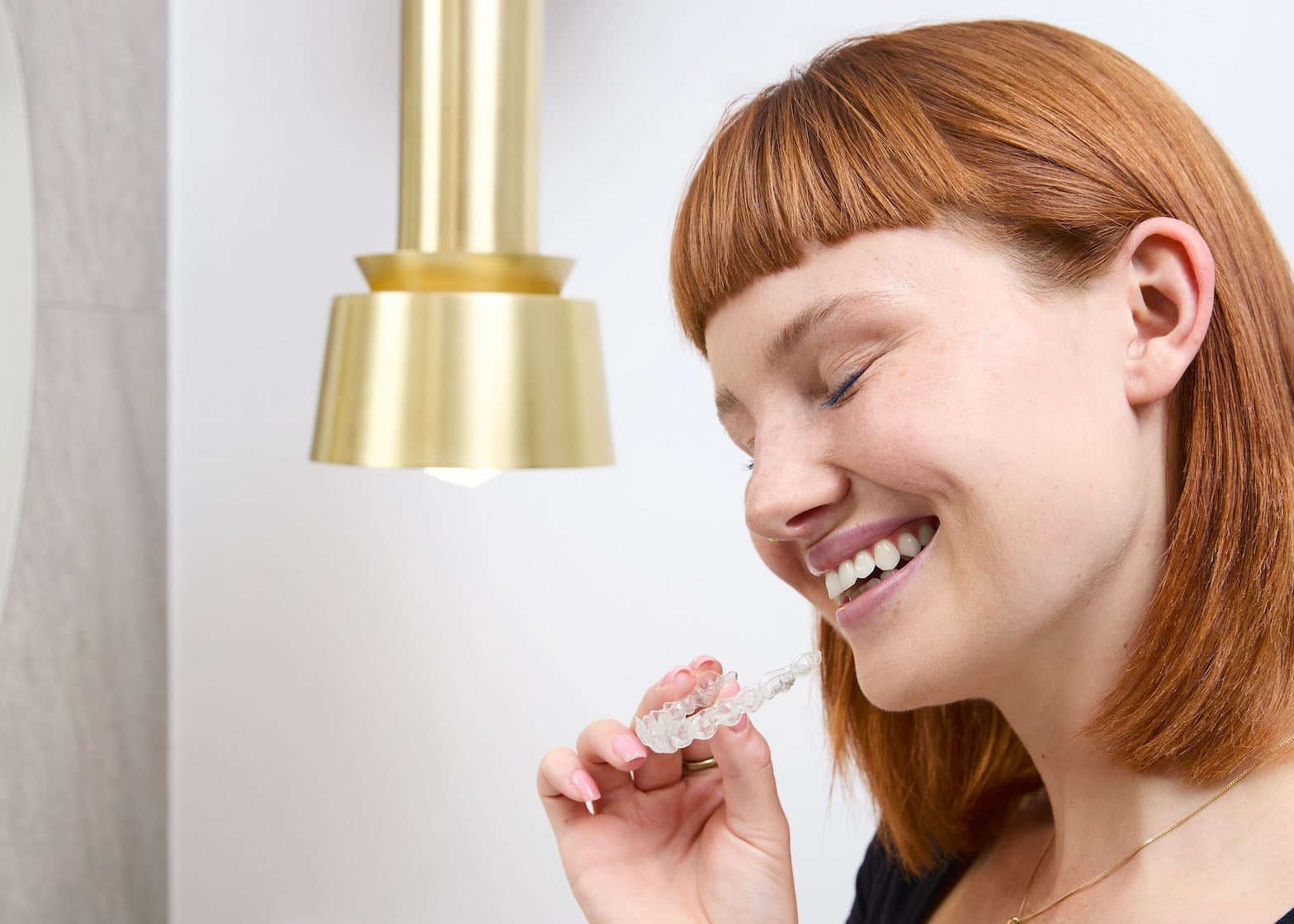Orthodontic treatment using clear aligners requires wearing them for about 22 hours a day. Removing the aligners is recommended only during meals and oral hygiene procedures. This intensive exposure makes proper cleaning of the aligners a key element of the therapy, directly affecting its effectiveness and patient comfort.
Why is proper hygiene of orthodontic aligners so important?
Orthodontic aligners, worn for most of the day, are exposed to a number of factors that can affect their condition and properties:
- bacterial plaque accumulation – microorganisms present in the oral cavity settle on the surface of the aligners, forming a biofilm similar to that which accumulates on teeth,
- potential staining – prolonged contact with pigments contained in saliva can lead to loss of transparency of the aligners and their gradual yellowing,
- hard-to-reach areas – the anatomically fitted shape of the aligners creates spaces that are difficult to reach using conventional cleaning methods,
- risk of caries and inflammations – improperly cleaned aligners can accumulate harmful bacteria, increasing the risk of oral diseases.
 Clinical studies confirm that simply rinsing aligners with water or cleaning them with a soft brush often does not provide an adequate level of hygiene [1].
Clinical studies confirm that simply rinsing aligners with water or cleaning them with a soft brush often does not provide an adequate level of hygiene [1].
SEE ALSO: Orthodontic aligners - disadvantages, advantages, costs [...]
Ultrasound in orthodontic hygiene
Ultrasonic cleaners, previously used mainly in dental offices and laboratories, are becoming an increasingly popular element of home hygiene for orthodontic patients. This technology uses the phenomenon of cavitation, which is the formation of tiny bubbles in water that collapse, producing microscopic sound waves. These waves effectively remove contaminants even from the smallest gaps in the aligners.
This process is characterized by:
- accuracy – sound waves penetrate even the tiniest gaps in the aligners,
- gentleness – the absence of mechanical friction eliminates the risk of micro-damage to the aligner surfaces,
- microbiological effectiveness – significant reduction in the number of microorganisms on the aligner surfaces.
Cleaning protocol for orthodontic aligners using an ultrasonic cleaner
The correct procedure for cleaning aligners in an ultrasonic cleaner includes the following steps:
- Rinse the aligners under running water immediately after removal.
- Place the aligners in the cleaner chamber filled with water.
- Optionally add a specialized orthodontic aligner cleaning agent (according to the manufacturer's recommendations).
- Start the cleaning cycle (usually lasts 3-5 minutes).
- Rinse the aligners with clean water after the process is complete.
SEE ALSO: Dental ultrasonic cleaner – what kind of device is it [...]
Regular use of this protocol helps maintain optimal transparency of the aligners throughout their usage period.
Ultrasonic cleaner ZENT Ultrasonic Cleaner – a specialized solution in orthodontic hygiene
Various models of ultrasonic cleaners are available on the market, among which ZENT®Ultrasonic Cleaner stands out, designed specifically with the needs of orthodontic patients in mind. This device is characterized by:
- effective elimination of microorganisms – confirmed reduction in the number of bacteria and pathogens,
- preservation of aligner transparency – prevention of dulling and yellowing of the aligners,
- prevention of bacterial plaque buildup – preventing biofilm formation on the aligner surfaces,
- protection of aligner structure – no micro-scratches often caused by mechanical cleaning,
- time efficiency – a complete cleaning cycle takes only a few minutes.
 Specialist recommendations regarding orthodontic aligner hygiene
Specialist recommendations regarding orthodontic aligner hygiene
Orthodontists and dental hygienists recommend:
- cleaning aligners after each removal, especially after meals,
- using an ultrasonic cleaner at least once a day, optimally morning and evening,
- avoiding cleaning aligners with toothpaste, which may contain abrasive particles,
- regular checks of the aligner condition during orthodontic visits.
Proper hygiene of aligners not only ensures an aesthetic appearance but above all constitutes an important element of caries and gum disease prevention during orthodontic treatment. Investing in specialized tools for aligner care directly translates into therapy comfort and reduces the risk of dental complications.
_______________________________________
- Souza RF, Paranhos Hde F, Silva-Lovato CH, Abu-Naba'a L, Fedorowicz Z, Gurgan CA. "Interventions for cleaning dentures in adults." Cochrane Database Syst Rev. 2009;(4):CD007395.
_______________________________________
 Paulina Koziar – dental hygienist who, thanks to her experience and passion, created ZENT Dental Box, a subscription hygiene set tailored to the real needs of users. Her professional goal and dream is a Poland without caries. With this mission, she inspires others to take care of a healthy smile daily in a convenient, effective, and modern way. In her texts, Paulina shares knowledge and emphasizes that daily oral hygiene requires not only regularity but also properly selected products that make the routine easier and more effective.
Paulina Koziar – dental hygienist who, thanks to her experience and passion, created ZENT Dental Box, a subscription hygiene set tailored to the real needs of users. Her professional goal and dream is a Poland without caries. With this mission, she inspires others to take care of a healthy smile daily in a convenient, effective, and modern way. In her texts, Paulina shares knowledge and emphasizes that daily oral hygiene requires not only regularity but also properly selected products that make the routine easier and more effective.




